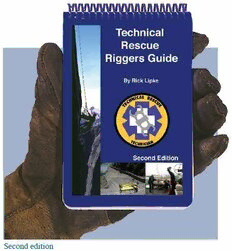
Technical Rescue Riggers Guide PDF
Preview Technical Rescue Riggers Guide
H £ 0o C O( ) 0 <( CD/O 3(1 C ) ) C ( OO 20 O3 ) )) Briefing for Technical Rope Operation - Quick Reference 1) Here's What 1 think we face; 2) Here's what 1 think we should do; **Galener 3) Here's why; 4) Here is what we should keep an eye on; 5) Now talk to me... •"Adapted from Dr. Karl Weicke. University of Michigan. 1995 • Assign a Safety officer (if possible) • List special safety concerns • Establish hazard zone • Establish edge transition location • Establish a line of direction for mainline cfiSipec• Explain mainline specifics • Explain needed edge transition techniques • Explain expected time frames • Assign package operators • Designate anchors • Assign a Control officer (if possible) ) > ) i ( ( ( ( ( ( ( i ( ( ( ( ( { oouiuieups }ojiaoiimoel uoda oaajeuou on!3|> U3^ajauoa«^; -I( OHISI ON 1H3 S3li )v|| od9JB;ojs bmai' mim Euauiiou ou yiBBaj ]OJ oouijol[( Z{ d3VQAi )iupiOBias mst b dB0|>EB8 doyjou o) ma sAsiaul js jaBpA }0 odajEia• PWrSiSIAB-B- £( VdddOVOH iH3 3Q53i )auuB ma dEiiaul dBpiBSa iuio odsjB- roubi dositjou lou qaiBA[( ddadVU31013NSI0Ni )mierunua odajB)ojs jautoAa buA S|BP> )joiu ma sAsiam' Bup qoip ma |!U8 }]6m( 9( 13NSI0N XH3 SAS.J3l\/li ) dojoa |s sddiiap ]o JUBiuijua qA 8BS|u6 oabj ma 9p6a' AaD)ouu6 ]saa qa|)MA[ OJ JB!S|U6( A30X0Ui )nEiajB( }ojoa is eddiiapio iuEiuiiua )0erp ]u EiJEusmou(• U3|-3VS3A30XOUi )nsiajBi )ojoa is S|om|A jaiaBsap( QOMNj )nOAAaj iqe dpaut/jesone dEotSEBe sdaap O( |omaj ispipeiap qA OBp0uoa: aOMN- a0MN"'a0MN■••(■ QOMN SIOMHA j )sio« eup 6aui|a io«aj( lf d j )uEise ma dEijaul/ aasona dE0|>B6a(• y3S3}i )e|io« ma uieruiiue jEiDqal io S9) Eup ma dn||ef efsiBju )O qe jasal ] uo S)Od OOUtUUEUp !S U833SSejA M8J9[( SlOdi )siods me sAsieul iu bu 8JU8j6auoA* oj ^oj e seje^A OOUOBJU' oeu q9 6iAeu qX euAoud ju )q0 sAsieul(' MHA SXOdc )vs|>ep qA deoHBfie odeieiojs io Bel !uiojiueijou eyaj SlOd ooiuiueup jS 6iAdu(- U03|>i U03|)i UOO|)i )oq!eot!S)eii!"6'aoNoiTooxnd(• ..)woje oouiiueup eup oojumnuiOBuou efstsius ou deBs .ist( Property of: CONTERRA 0 If you would like to order more copies of this guide, have questions or comments about this guide, or would like a catalog of our complete line of EMS and rescue equipment, please contact us at: CONTBRRA TECHNICAL SYSTEMS INC. 1600 Kentucky Street # A-3'Bellingham, WA 98229 PH (360)734-2311-FAX (360) 738-2241 EMAIL [email protected] WEB www.conterra-inc.com Authors note: This guide contains information on basic rescue techniques only. Many important skill and concepts cannot be properly shown in a guide of this kind, and have therefore been omitted. For complete instruction, please contact a reputable rescue school. Copyright © 2009 by Conterra Inc. All rights reserved. No part of this publica tion may be reproduced, stored in a retrieval system, or transmitted, in any form or by any means, electronic, mechanical, photocopying, recording, or otherwise, without the prior written permission of the copyright owner. We will prosecute copyright violators to the fullest extent of the law. Second edition: 1st printing 3/97 , . . 2ndprin,ing 7/97 f ^'09 ® 2ndpnnting J/11 Revised first edition: 1st printing 10/97 9th printing 9/05 2nd printing 1/98 10th printing 1/06 3rd printing 7/98 llth printing 7/07 4th printing 7/00 12th printing 7/08 5th printing 10/01 6th printing 1/02 ISBN 0-9665777-1 -X 8th pnnting 7/04 ) ) ) ) ) ) ) » > > > > > > ) ) ) ) ) ) ) ) ) ) ) ) ) ) ) W A R N I N G ! A Read this Carefully: The skills and techniques shown in this guide are for expert use only! Even when properly performed, loss or injuries may result, you could die, or you could kill someone else. It is your responsibility to seek competent hands on instruction in rope rescue, and the specific techniques shown in this book before ever trying them in the field. Conterra Inc. and/or the author accept no responsibility for loss, damage, injury, or death, result ing from information contained in, or omitted from, this guide. What this guide is- The techniques shown within this guide represent a "paradigm shift" in mod ern rope rescue. Since the mid 1980's, a new generation of rescue techniques have evolved, borrowing heavily from work done by Rigging for Rescue in Canada- focussing on light equipment, quick response, and a high degree of safety and flexibility. These techniques have been found to work equally well in the back country as well as the industrial setting. If your rescue team is not currently using some or all of the techniques shown in this guide, we. hiphlv recommend that vou update vour training. There are several excellent rescue schools located around N. America that are skilled in these techniques. If you have questions or need updated training, please feel free to contact Conterra Inc. for recommendations on a school near you. How to use this Guide- This guide is intended as a field reference for rescuers already trained in, and familiar with, these techniques. The technical illustrations are cross ref erenced by page number, so that you can quickly zero in on the exact rigging technique in question. Starting at an overview page ( High Angle Raise, for example), follow the page references to the subject you wish to view. System Overview Slopes, Risk and Ropes Risk Assessment Risk assessment on this page is based on probability of a mishap -f consequences of a mishap + person nel in harms way + objective hazard [eg rockfail]. o o■a>c*-> OoEE(0co■ (/)>^inBE (8) Rigger {and/or control) Belay Main line Rescue/Patient Edge package package package package The technical rescue system System components
